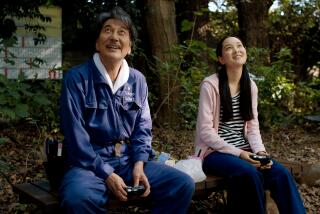FILM : Bergman’s Self-Revelatory Odyssey
- Share via
A lifetime of regret reaches out and spooks an old man in “Wild Strawberries,” the film that cemented Ingmar Bergman’s reputation as one of the world’s important directors.
“Wild Strawberries” is an astute choice for the UC Irvine Film Society’s Directors’ Personal Portrait series. With the possible exception of “The Seventh Seal,” it may be the movie most intimately associated with this masterly Swedish filmmaker.
When released in 1957, “Wild Strawberries” provoked the international film community, just as his impressionistic “The Seventh Seal” had done the year before. Many critics were baffled by the unusual construction and symbolism, but many more hailed it for what it was--a work that mixed poignancy, intelligence and glimmers of the subconscious man, and took the narrative form in fresh directions.
Bergman’s preoccupations with death, spiritual truth and rejuvenation, and the underlying eroticism of the physical world are on display. These themes, and the symbolic way he approaches them, would become personal signatures.
The beginning is hallucinatory. Isak Borg (Victor Sjostrom), a 78-year-old doctor known for his hard principles, is having a dream that eventually becomes a nightmare. The scene is blanketed with metaphor--timepieces without hands, a rushing, out-of-control hearse drawn by black horses, a pervading isolation that comes from the deserted town square Isak walks through aimlessly. The hearse crashes and a coffin falls out. The corpse reaches out to Isak, who sees that it is he who is dead. He wakes with thoughts of his mortality and decides to drive instead of fly to pick up an honorary degree at a distant university.
Isak takes his lovely daughter-in-law (Ingrid Thulin) and picks up three young hitchhikers (Bibi Andersson, Bjorn Bjelvenstam and Folke Sundquist) after they stop at his boyhood home. From there, Bergman places Isak in several nostalgic reveries, juxtaposing the present with his bittersweet past. The trip becomes an odyssey of self-revelation and grudging acceptance.
This isn’t an easy movie. At times, it isn’t even that enjoyable; the melancholy and introspection often freeze-dries the action. And, typical of Bergman, “Wild Strawberries” requires the audience’s thoughtfulness throughout. But it’s worth the attention. Many images linger, as does Isak as a metaphor for anyone who has considered where they’ve been, where they’re going and what they’ve become.
More to Read
Only good movies
Get the Indie Focus newsletter, Mark Olsen's weekly guide to the world of cinema.
You may occasionally receive promotional content from the Los Angeles Times.










